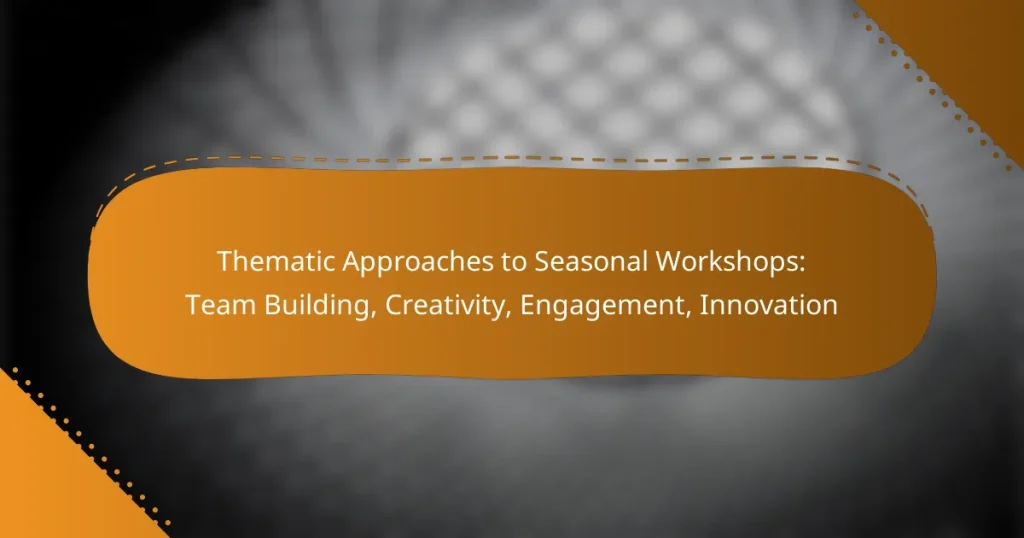Seasonal workshops offer a unique opportunity to enhance team building, creativity, engagement, and innovation within organizations. By fostering a collaborative environment, these workshops encourage employees to connect, communicate, and develop essential skills through engaging activities. This approach not only stimulates creativity but also strengthens team dynamics, resulting in a more motivated and cohesive workforce.
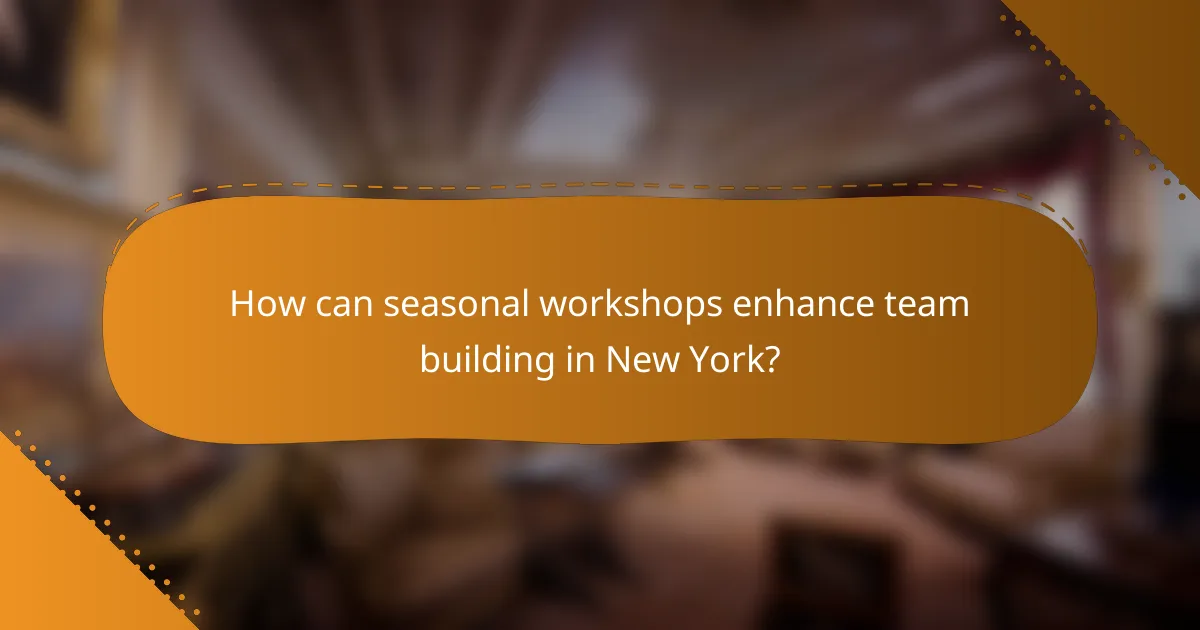
How can seasonal workshops enhance team building in New York?
Seasonal workshops in New York can significantly enhance team building by fostering a collaborative environment where employees can connect and develop essential skills. These workshops often focus on activities that promote communication, creativity, and problem-solving, leading to a more cohesive team dynamic.
Improved communication skills
Seasonal workshops provide a platform for team members to practice and enhance their communication skills. Engaging in group activities encourages participants to articulate their thoughts clearly and listen actively to others, which is crucial for effective teamwork.
Workshops can include role-playing exercises or team challenges that require open dialogue. For instance, a workshop might involve a scenario where teams must solve a problem together, necessitating clear communication to succeed.
Strengthened relationships
Participating in seasonal workshops helps to build stronger relationships among team members by creating shared experiences. These interactions can break down barriers and foster trust, which is essential for a healthy work environment.
Activities such as team-building games or collaborative projects allow employees to see each other in a different light, enhancing camaraderie. For example, a cooking class where teams prepare a meal together can lead to bonding over shared successes and challenges.
Increased collaboration
Workshops designed for team building encourage collaboration by providing structured opportunities for teamwork. Participants learn to work together towards common goals, which can translate into improved collaboration back in the workplace.
Incorporating group tasks that require diverse skills can highlight the importance of each team member’s contributions. For instance, a workshop might involve a creative brainstorming session where teams generate ideas for a new project, reinforcing the value of collaborative input.
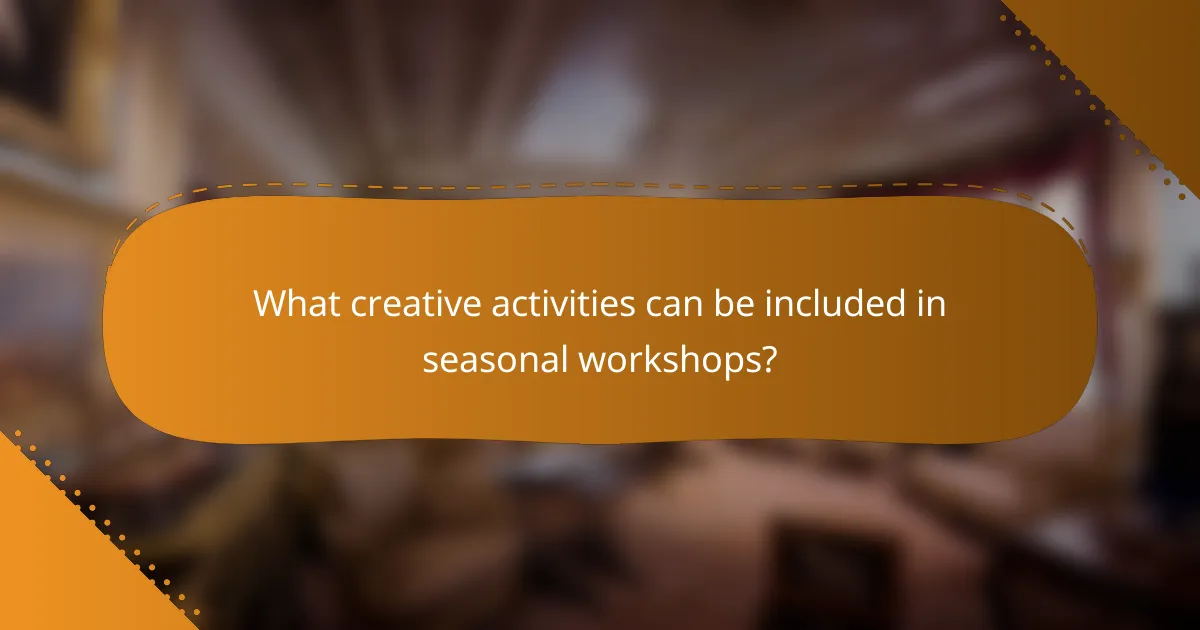
What creative activities can be included in seasonal workshops?
Seasonal workshops can incorporate a variety of creative activities that foster team building, enhance engagement, and stimulate innovation. These activities should be designed to encourage collaboration and allow participants to express their creativity in a supportive environment.
Artistic expression sessions
Artistic expression sessions provide participants with the opportunity to explore their creativity through various mediums such as painting, sculpture, or crafts. These sessions can be structured as guided workshops or open-ended explorations, allowing individuals to express their ideas freely.
Consider incorporating local art styles or materials to enhance cultural relevance. For example, using natural elements or traditional crafts can connect participants to their surroundings and foster a sense of community.
To maximize engagement, ensure that all materials are readily available and that participants feel comfortable sharing their creations. Encourage a non-judgmental atmosphere to promote openness and collaboration.
Brainstorming challenges
Brainstorming challenges are designed to stimulate innovative thinking and problem-solving among team members. These activities typically involve presenting a specific problem or goal and encouraging participants to generate as many ideas as possible within a set timeframe.
Utilize techniques such as mind mapping or the “six thinking hats” method to guide discussions and ensure diverse perspectives are considered. Setting clear objectives and time limits can help maintain focus and energy throughout the session.
To enhance the effectiveness of brainstorming challenges, consider using digital tools or apps that allow for real-time collaboration, especially in hybrid or remote settings. This can help capture ideas efficiently and keep everyone engaged.
Interactive storytelling
Interactive storytelling involves participants collaboratively creating narratives that can reflect their experiences or aspirations. This activity can be facilitated through various formats, such as role-playing, group discussions, or digital storytelling tools.
Encourage participants to draw from personal stories or shared experiences to create a richer narrative. This not only fosters creativity but also strengthens team bonds as individuals connect over shared themes and emotions.
To ensure inclusivity, provide prompts or themes that resonate with all participants. This can help guide the storytelling process and ensure that everyone feels comfortable contributing their voice to the collective narrative.
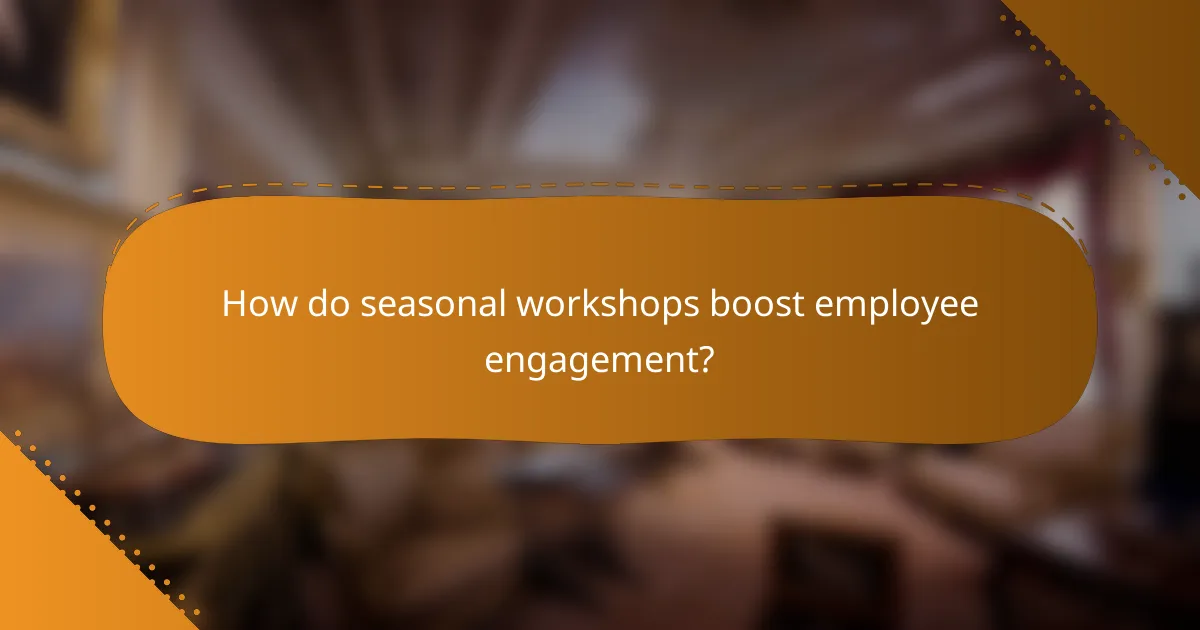
How do seasonal workshops boost employee engagement?
Seasonal workshops significantly enhance employee engagement by creating dynamic environments that foster collaboration and creativity. These workshops not only break the routine but also encourage team bonding, leading to a more motivated workforce.
Increased motivation
Seasonal workshops can invigorate employees by introducing fresh challenges and learning opportunities. When participants engage in activities outside their usual tasks, they often feel a renewed sense of purpose and excitement about their roles.
To maximize motivation, consider incorporating elements that align with employees’ interests, such as creative problem-solving exercises or team-building games. This alignment can lead to higher participation and enthusiasm.
Enhanced job satisfaction
Participating in seasonal workshops can lead to improved job satisfaction as employees feel valued and invested in. Workshops that focus on personal and professional development signal to employees that their growth matters to the organization.
Employers should ensure that these workshops address relevant skills and interests, creating a direct link between the workshop content and employees’ daily responsibilities. This relevance can significantly boost overall job satisfaction.
Opportunities for feedback
Seasonal workshops provide a unique platform for employees to share feedback in a relaxed setting. This open dialogue can lead to valuable insights about workplace culture and processes, helping organizations to adapt and improve.
Encouraging feedback during these workshops can be facilitated through anonymous surveys or group discussions. This approach not only empowers employees but also fosters a culture of continuous improvement within the organization.

What innovative approaches can be applied in seasonal workshops?
Innovative approaches in seasonal workshops can enhance team building, creativity, engagement, and innovation. Techniques such as virtual reality experiences, gamification, and design thinking methodologies can transform traditional workshops into dynamic and interactive learning environments.
Virtual reality experiences
Virtual reality (VR) experiences immerse participants in a simulated environment, promoting engagement and collaboration. By using VR headsets, teams can explore scenarios that encourage problem-solving and creativity, such as virtual team challenges or simulations of real-world situations.
Consider incorporating VR activities that align with your workshop’s goals. For example, a team-building exercise could involve navigating a virtual obstacle course, fostering communication and teamwork. Ensure that the technology is user-friendly and accessible to all participants.
Gamification techniques
Gamification techniques involve applying game-like elements to non-game contexts, making workshops more engaging and motivating. This can include point systems, leaderboards, and rewards for participation or achievement, which can drive competition and enhance learning outcomes.
To implement gamification, define clear objectives and rules. For instance, you could create a point system for completing tasks during the workshop, with prizes for top performers. Be mindful of balancing competition with collaboration to maintain a positive atmosphere.
Design thinking methodologies
Design thinking methodologies focus on understanding user needs and encouraging innovative solutions through a structured process. This approach typically involves stages such as empathizing, defining, ideating, prototyping, and testing, which can be applied to various challenges faced by teams.
Incorporate design thinking into your workshop by guiding participants through real-world problems relevant to their work. Encourage brainstorming sessions and collaborative prototyping to foster creativity. Providing tools like sticky notes or digital platforms can help capture ideas effectively.
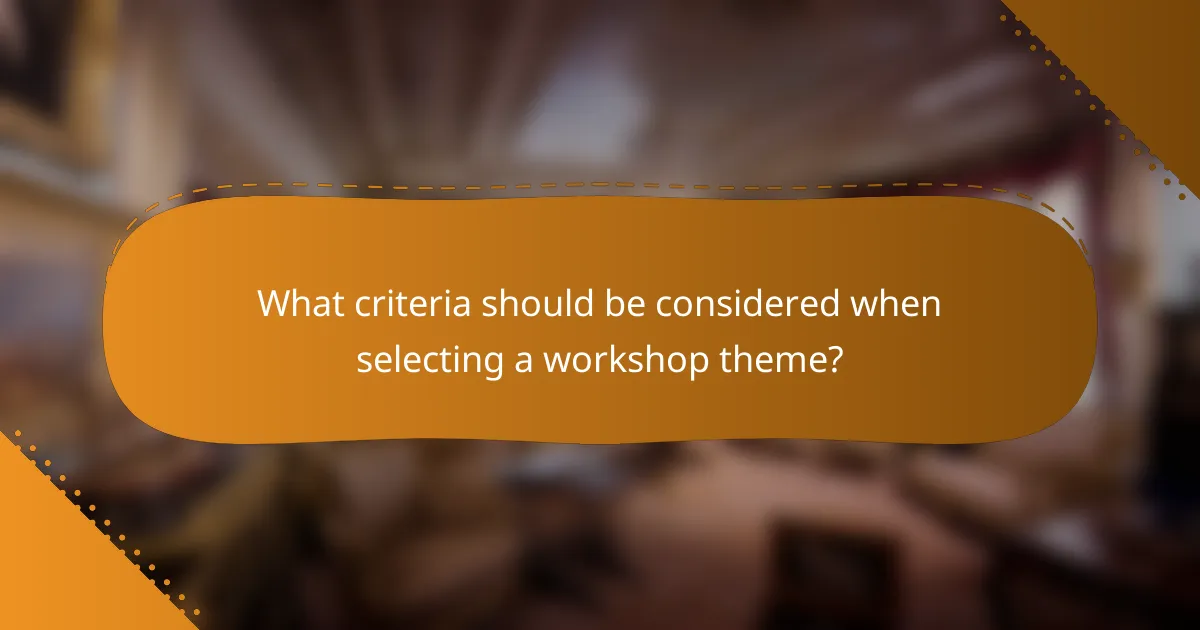
What criteria should be considered when selecting a workshop theme?
Selecting a workshop theme requires careful consideration of several key criteria to ensure it meets the needs of both the organization and its employees. Important factors include alignment with company goals, relevance to employee interests, and budget constraints.
Alignment with company goals
The workshop theme should directly support the strategic objectives of the organization. For instance, if a company is focusing on enhancing innovation, a theme centered around creative problem-solving would be appropriate. Consider how the workshop can contribute to broader initiatives, such as improving team collaboration or increasing productivity.
To evaluate alignment, review the company’s mission statement and current goals. This will help in identifying themes that reinforce the desired direction and outcomes. Engaging leadership in this process can also provide valuable insights into priority areas.
Relevance to employee interests
Choosing a theme that resonates with employees is crucial for engagement and participation. Conduct surveys or informal discussions to gauge interests and preferences. For example, if employees express a desire for skill development in digital tools, a workshop on technology and creativity would be well-received.
Consider demographic factors such as age, job roles, and professional backgrounds when selecting themes. Tailoring the workshop to meet diverse interests can enhance overall satisfaction and effectiveness, leading to a more motivated workforce.
Budget considerations
Budget is a critical factor when selecting a workshop theme, as it determines the scope and scale of the event. Establish a clear budget range early in the planning process to guide theme selection. Costs may include venue rental, materials, facilitators, and refreshments.
To manage expenses effectively, prioritize essential elements of the workshop. For example, consider using in-house resources for facilitation or opting for virtual formats to reduce costs. Always leave room for unexpected expenses by allocating a small percentage of the budget for contingencies.
